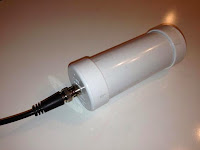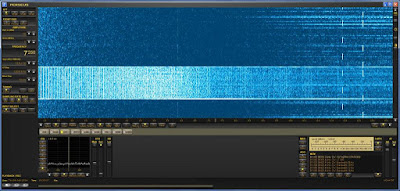 PAØRDT E-Probe Improved VLF Noise Performance
PAØRDT E-Probe Improved VLF Noise Performance
 |
| courtesy: http://www.leeszuba.com/projects/ |
A recent blog posting of four videos showing the installation of a new (Roelof-made) PAØRDT active E-probe antenna revealed that there appeared to be a difference between his earlier model and his latest. It was noticed that the noise ingression levels were different between them, with one showing less noise on LF than on HF, while the other one behaved just the opposite. The newer PFU has the antenna ground isolated from the receiver's ground while the older one does not. Noise coupling, with the new one was higher on HF and lower on LF, which was just the opposite of what was noted with the older unit with its un-isolated ground ... overall LF performance over the newer system was deemed to be better as seen in the final video here.
The only difference seemed to be in the coupling isolation transformer, used in the power feed unit (PFU), likely similar to the one shown at the bottom of this page.
Roleof's transformers are wound on a Magnetics 0W40705TC toroid, whose high mu ferrite has an Al value of ~8350. I mentioned to Roelof that is seemed unusual that the noise levels would be greater on HF than on LF, with the new transformer, as usually it's the other way around when it comes to noise. The changes noted in the video lead to further transformer testing by Roelof, who indicated :
The isolating transformer consists of two bifilar windings on a high mu core. My guess is that the interwinding capacitance spoils the isolation at HF. I have just tested an isolating transformer with two separate windings opposite each other on the tiny core. Sure enough, this solves the feedthrough at HF and VLF performance is not impaired at all.
I have never given this a second thought as I believed it was specific for my location. Never too old to learn!
Further testing indicated:
I have evaluated both transformer types on my spectrum analyser and found the following.
The current transformer with a twisted bifilar winding is a
transmission line transformer. In a 50 ohm system, it covers 4 kHz (!) to 200 MHz at -3dB. Which is very good.
The new one, using the same core and separate windings is an other
story. It covers just 4 kHz to 8 MHz at -3dB. At 30 MHz the loss is
13 dB. So, excellent for VLF / LF/ MF, it won't do for upper HF.
I will try other core material and see if a feasible compromise is
possible.
To be continued.
further...
I first tried a FT-37-43 toroid with 10 turns for each winding.
This core is suitable for higher frequencies and I expected it to
work better than my high mu (8300) cores.
Nope, it was far worse and at 30 MHz the loss was already > 20 dB.
I reverted back to my magical cores and reduced the number of turns
to 3. This yielded a nice bandwidth (-3dB)from 50 kHz to 50 MHz.
Used in the mini-whip interface, there is no more a difference
between shared grounds and isolated grounds on either VLF / LF or
HF.
Though the lower -3dB point is at 50 kHz, I still have excellent
reception of the Russian Alpha stations between 10 and 15 kHz.
It looks like this transformer is an excellent compromise for this
purpose.
I have often found that in practice, high mu cores are excellent for
wideband transmission line transformers. They are good for
traditional rf transformers as well!
and:
I just have tested a binocular core, the BN-73-202, available from
W8DIZ.
With two windings of two turns each of insulated hook up wire (to
keep interwinding capacitance low), gives a transformer from 80 kHz
to over 100 MHz. In practice reception down to 10 kHz is still
excellent.
There is no difference between isolated or common grounds either.
The coupling with this binocular core is a little better than with a
toroid. At LF / MW, I don't find any loss at all.
The FT-50-75 will do fine with two windings of 4 turns each.
I have some FT-50-77 cores at hand and will see how they work out.
I am surprised at the wide bandwidth that can be achieved.
and:
I have been testing a FT-50-77 ferrite toroid for use as wideband
isolation transformer.
Three turns on the Magnetics (aka magical) cores, give an inductance
of 60 uH. Used as a wideband Isolation transformer, the -3dB
bandwidth ranges from 80 kHz to 50 MHz.
For about the same inductance, the FT-50-77 core needs 6 windings.
Used as wideband isolation transformer, the lower - 3dB point is 100
kHz, the upper is 12 MHz. At 30 MHz the loss is already 8.5 dB.
Though not suitable as wideband isolating transformer, it still can
be used for the range 100 kHz - 3 MHz.
It looks that for good wideband performance the Al value must be >
5000 and the number of turns should be =< 3.
Interesting stuff and the best thing is that it has really lowered
my noise floor!
A summary posting to the RSGB's LF reflector indicates that the new transformer scheme is providing quieter VLF reception and good performance up to 200MHz
For years, I have been using a rf - isolating transformer to
separate antenna and receiver ground.
This is a home made transmission line transformer, consisting of 11
bifilar turns on a small high mu toroid (AL=8300). The inductance is
1.2 mH. The measured -3dB bandwidth in a 50 ohm system covers 4 kHz
- 200 MHz.
It appeared that the isolation was not perfect, due to the
inter-winding capacitance. I have made a new transformer on the same
core with two windings of each tree turns. The windings are opposite
each other on the core. The bandwidth is now 45 kHz - 50 MHz. The
loss is 1.3 dB.
Despite the raise in the lower -3dB point, reception at VLF is much
improved due to lower noise ingress. See attachment.
The screen runs from 1 kHz - 13 kHz. At the right hand the dashes
from the Russian Alpha system can be seen. The white band is with
common ground. Harmonics of the 50 Hz mains can be easily spotted.
In reality the picture will be better,as the sensitivity of the
PERSEUS drops considerable below 10 kHz.
The level of interference on 380 kHz caused by a plasma TV in the
neighbourhood is also much reduced.
An excellent video demonstrating the dramatic effects of isolating the ground in the e-probe antenna system on LF was posted today by PY3CRX. Marcus used the Magnetics hi-mu core with 5 + 5 turns (~ 390 + 390 uh).
For those not having access to the Magnetics material, it looks like the BN-73-202 binocular core is a good performer, from 10kHz - 100MHz. The FT-75 and 77 material also fair well but with differing bandwidths. Cores are available from Amidon as well as from W8DIZ's Kits & Parts.














